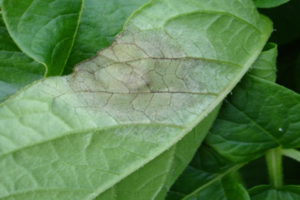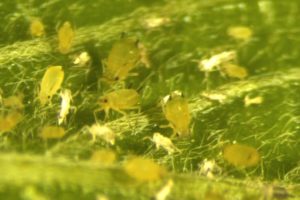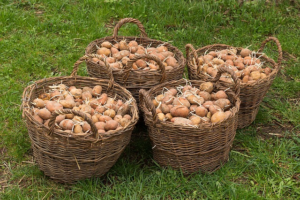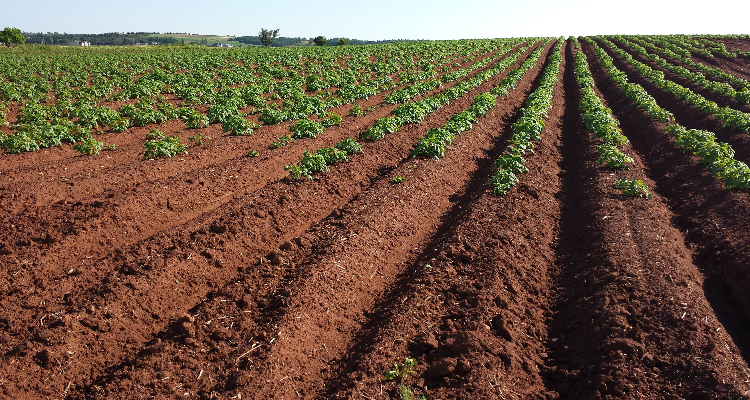Virus management in seed potatoes
24 April 2020The 6 Steps to Effective Virus Management
The virus health of Scottish seed potatoes is a unique selling point in GB and around the world. However, the amount of virus in crops did increase significantly during 2019 to its highest level for some decades. After an exceptionally mild winter disease pressure in 2020 is going to be high. The opportunity exists for growers and the industry to bear down on the disease in 2020 to reduce virus levels not just for 2020 but into the following seasons.
The main virus of concern is PVY. And the main strain is now is PVYNTN. This virus can cause significant direct yield losses, tuber blemishes and cracking.
Our understanding of the effect of the changing environment, the changing pathogen, new varieties (sometimes not exhibiting symptoms in the foliage) and the effect of aphicide resistance is not as good as we would like. However, these guidelines have been produced after extensive discussion with industry and science experts. They represent the best available advice. But growers will need to discuss the recommended pesticide programmes with their BASIS qualified agronomist to ensure correct application to their unique set of circumstances.
Step 1
- Locate crops away from sources of the virus. High-grade crops should be isolated. Don’t plant near to fields where volunteers have not been controlled.
- Where possible, drill cereal strips around crops to divert incoming infected aphids.
Step 2
- Early removal of virus sources before it can spread.
- Rogue crops from soon after emergence. Control volunteers in neighbouring crops. Take out all ground keepers. Destroy or completely cover potato dumps.
- Keep roguing.
Step 3
- Understand your varieties.
- Look up the variety resistance on the AHDB website and propensity on SASA‘s website.
- Target high-risk varieties.
Step 4
- Track the enemy (aphids).
- Get yellow water traps set up. Or at least sign up for the warning systems. Inspect your crops regularly.
Step 5
- As soon as aphids are flying, Spray. And keep spraying until the crop has been burnt down.

- Follow the detailed guidelines to ensure an effective, reliable, and legal programme is followed.
- Sprays can be very effective against PLRV. They are not necessarily effective for PVY control.
Step 6
- Understand the limitations.
- Aphids can transmit PVY in around a minute, making control very difficult, so aphicides cannot be relied upon to provide control of PVY transmission.
- There is resistance to some aphicides in some aphid species.
- Mineral oils are useful to reduce virus acquisition and transmission of PVYN.
Protecting all seed potato crops from the various aphid-borne potato viruses is essential to maintain the quality of Scottish seed potatoes, particularly in light of the shrinking availability of aphicides for effective virus management.
Maintaining high-quality seed health now will help protect future crops when we lose further aphicides over the next few years by reducing the level of virus inoculum available to aphids. There was an unwelcome increase in the incidence of crops containing potato virus Y last season, which has increased the risk of virus-infected stocks being planted in 2020 and subsequent spread of the virus into the 2020 seed crop.
A conservative approach to maintaining high health seed stocks is recommended through a robust approach to aphid-borne virus management to avoid viruses entering the seed stock.
Removing sources of virus
The key focus should be on targeting and managing the potential sources of virus:
- The mother seed stock – i.e. the seed crop planted in the field

- Other seed and ware crops in proximity to the crop
- Groundkeepers/volunteers in potato and non-potato crops
- Potato dumps where haulm growth is present
Growing seed crops in an environment in which all sources of aphid-borne viruses are kept to a minimum is a key consideration in the production of healthy seed potatoes. This includes sources within the seed crop as well. High quality virus-free seed should be sourced to minimise the risks of spread from infected plants within the crop, supported by thorough roguing of any virus infected plants and groundkeepers at an early stage – preferably as early in the growth of the crop as practical – before aphid vectors of non-persistent virus are flying.
Risks from the local area should be addressed by attempting to isolate seed crops from potential external sources of virus, and by minimising the sources of virus available for aphids to acquire virus from. Adjacent fields should be checked for the presence of infected groundkeepers/volunteers and action taken as appropriate, including informing the owners of these crops on the benefits of groundkeeper management.
Neighbouring ware crops should be as free from virus as possible – the use of untested home-saved seed to grow ware can increase the risk. Preventing haulm growth on dumps is also important in limiting the opportunities for flying aphids to pick up virus and carry it into seed crops.
Roguing of groundkeepers/volunteers from non-potato crops, and potato plants exhibiting virus symptoms from ware and seed crops is an essential component of virus management in seed potatoes – aphids have to pick up virus from somewhere.
Aphids will acquire virus from the above sources if they contain virus infected plants, and some non-potato colonising aphids and all potato colonising aphids play a significant role in virus transmission.
Consider sowing cereal strips at the edges of both seed and ware crops, as they can purge the virus from the stylets of aphids before they move into the seed crop.
Potato viruses transmitted by aphids
There are two groups of aphid-borne viruses that are of concern in seed potatoes; persistent viruses (such as Potato leaf roll virus – PLRV) and non-persistent viruses (e.g. Potato virus Y – PVYO, PVYN, Potato virus A – PVA, Potato virus V – PVV).
The persistent virus PLRV resides in the phloem sap of plants and is acquired from infected plants by aphids feeding on the plants and ingesting sap. The ability of an aphid to transmit PLRV is then delayed for several hours because the virus has to pass through the digestive system of the aphid and enter its saliva before transmission can occur. Consequently, only potato colonising aphids will be transmitting PLRV. Once the virus has been acquired by an aphid, it remains infective for the rest of the aphid’s life.
The non-persistent viruses PVYO, PVYN , PVA and PVV are rapidly acquired when an aphid feeds on an infected plant because these viruses, which reside in most plant tissues including the leaf epidermal cells of plants, are carried on the aphid mouthparts. Non-persistent viruses can be passed on to another plant within a few minutes during aphid feeding. Consequently, winged aphids which briefly probe plants to determine whether they are suitable host-plants and then move onto another plant, have the potential to spread these viruses quickly within the crop. These winged aphids may be non-potato colonising or potato colonizing aphids, and several non-potato colonising aphid species are involved in PVY virus transmission.
Varietal propensity for virus
The term ‘varietal propensity’ has been adopted to describe whether virus symptoms observed within a variety are above or below the average across the whole Scottish seed crop. Whether a variety has a propensity to PLRV or to PVY can be used to determine the appropriate means of protecting the crop through an aphicide programme for the appropriate aphid vector species. For example, aphicide programmes could be less intensive for varieties that have a low propensity for virus infection. Propensity should also be considered in any planting programme as there will be advantages in ensuring that varieties with a propensity to say, PVY, are planted away from crops which are considered a likely source of inoculum for that virus.
Full details on varietal propensity can be found at on the SASA website.
Information on aphids
The cumulative appearance of aphids throughout the season can be monitored from the AHDB network of aphid water traps and the UK network of aphid suction traps at the following links:-
This information can be used as an early warning system for general areas and growers are strongly encouraged to use data from both the water traps and the suction traps to gauge the threat from aphids and virus in their area and monitor the virus pressure throughout the season.
Aphids that carry and transmit non-persistent viruses include non-colonising as well as potato-colonising species, and they can acquire and transmit virus to potatoes if they land and probe on a potato leaf. These non-colonising aphids include the bird cherry–oat aphid, the grain aphid, the rose–grain aphid, the apple–grass aphid and the willow-carrot aphid. The aphids that can colonise and multiply on potatoes include the peach–potato aphid, potato aphid and glasshouse–potato aphid.
Consequently, the timing and numbers of key aphids caught in the aphid water traps and suction traps can be used as a guide to the risk of aphid movement into potato crops, and potentially advise the beginning of the aphid management programme, taking into account the appearance of the key aphids listed below, rather than specific potato–colonising aphids.
Key aphids
Once any of the following aphids begin to appear in local water traps or suction traps then there is risk of transmission of non-persistent viruses and aphid management programmes should start.
- Myzus persicae – Peach–potato aphid
- Acyrthosiphon pisum – Pea aphid
- Rhopalosiphum padi – Bird cherry–oat aphid
- Aphis nasturtii – Buckthorn–potato aphid
- Metopolophium dirhodum – Rose–grain aphid
- Brachycaudus helichrysi – Leaf-curling plum aphid
- Rhopalosiphoninus latysiphon – Bulb and potato aphid
- Myzus ornatus – Violet aphid
- Myzus ascalonicus – Shallot aphid
- Macrosiphum euphorbiae – Potato aphid
- Aulacorthum solani – Glasshouse–potato aphid
- Hyperomyzus lactucae – Currant–sowthistle aphid
- Aphis fabae – Black bean aphid
- Sitobion avenae – Grain aphid
- Brevicoryne brassicae – Cabbage aphid
- Cavariella aegopodii – Willow-carrot aphid
Note that those in bold are the aphid species that can colonise potatoes, but all the aphids listed above can transmit non-persistent viruses.
Aphid management programmes
Several aphicides that growers are familiar with are no longer available or have restricted uses this season. The active substance pymetrozine (e.g. Plenum) and the neonicotiniod thiamethoxam (e.g. Actara) are no longer available. The active substance flonicamid (e.g. Teppeki) can only be used on crops that will not have any of the harvested tubers ending up in the human or animal food chain.
In mainland Europe some mineral oils are approved as plant protection products (PPP) and so can be used alone. In UK the available mineral oils are adjuvants (and not PPPs) and must be used with an approved PPP such as an insecticide, fungicide or herbicide. Trials have been carried out in UK under experimental permits to evaluate the effect of mineral oils, alone or in combination, on virus transmission. Differences in effectiveness were observed but the reasons for this have not been fully determined. Vegetable oils have been less well studied in UK and we have no evidence on their effectiveness.
Overseas (e.g. Canada and the Netherlands) mineral oils are being used as PPP from 30% crop emergence onwards as weekly treatments, but in the UK mineral oil adjuvants are not approved for application beyond tuber initiation. Note that mineral oils are not compatible with the potato blight fungicides Ranman Top, Shirlan, or the aphicide Biscaya. However, trials have demonstrated that the mixture of oils with the blight fungicides Invader, Percos and Revus improved levels of blight control.
There are several aphicides that can play a role in virus management in seed potato crops (see Table 1). However, peach–potato aphids resistant to pyrethroid aphicides (esfenvalerate and lambda-cyhalothrin), are now in the majority in Scottish and English potato and vegetable crops, and there is reduced sensitivity to pyrethroids in other aphid species such as the grain aphid and willow-carrot aphid. Correct choice of aphicide is crucial to minimise the risk of aphicide-resistant aphids developing on crops and consequently transmitting virus. A spray programme that alternates differing chemical groups is essential to minimise the transmission of the virus by aphids and reduce the risk of resistance.
- Mineral oil or vegetable oil can be applied with a PPP up to tuber initiation (e.g. Newman Cropspray 11E, Headland Fortune).
- A rapid knock-down pyrethroid component (lambda-cyhalothrin or esfenvalerate) has been a common component of PVY reduction programmes as the chemical has a rapid kill of aphids and also potentially acts as a deterrent to aphid probing of treated leaves, thus reducing the risk of the virus being acquired and transmitted. When peach-potato aphids, grain aphids or willow-carrot aphids appear in traps, relying on pyrethroid aphicides alone is not advisable, as these aphids are likely to be resistant to this group of aphicides. However, other non-colonising aphid species with differing abilities to transmit the virus are considered to be fully susceptible to these pesticides.
- A translaminar component (acetamiprid, flonicamid, thiacloprid, spirotetramat) which is taken up by the leaf and kills aphids that feed on the leaves is recommended when peach-potato aphids appear. These aphicides will target any colonising aphids and prevent their multiplication on the crop and subsequent spread of the virus to adjacent plants. These treatments will be particularly effective in the control of PLRV. These aphicides will target any colonising aphids and prevent their multiplication on the crop and subsequent spread of the virus to adjacent plants. These treatments will be particularly effective in the control of PLRV.
No more than two applications of a neonicotinoid product (acetamiprid, thiacloprid) can be applied in a season, and are not to be used in consecutive sprays.
Of the aphicides listed above, acetamiprid, flonicamid, thiacloprid and spirotetramat are the only products to which peach–potato aphids are not known to show any resistance, so they are an essential component of an anti-resistance strategy against this species and should be used when peach-potato aphids have been found in aphid traps.
The following aphicides are approved for use on seed potato crops in 2020
| Aphicide Group | Active ingredient(s) | Products | Max No. of applications of each product |
|---|---|---|---|
| Pyrethroid | esfenvalerate | Barclay Alphasect, Clayton Cajole, Clayton Slalom, Clayton Vindicate, Gocha, Kingpin, Sumi-Alpha, Sven | 4 |
| Pyrethroid | lambda-cyhalothrin | Balliol, Clayton Lambada, Clayton Lanark, Clayton Sparta, CleanCrop Argent, CleanCrop Corsair, CM Lambaz 50 EC, Colt 10 CS, Dalda 5, Eminentos 10 CS, Euro Lambda 100 CS, Hallmark with Zeon Technology, Hockley Lambda 5EC, Karis 10 CS, Kendo, Kung Fu, Kusti, Laidir 10 CS, Lambda-C 100, Lambda-C 50, Lambdastar, MAC Lambda Cyhalothrin 50 EC, Markate 50, Martlet, Ninja 5CS, Reparto, RouteOne Lambda C, RVG Lambda-cyhalothrin, Seal Z, Sparviero, Stealth, Triumph, Triumph CS, Warrior | 4 |
| Neonicotinoid | acetamiprid* | Insyst, Persist | 2 (1 on ware) |
| Neonicotinoid | thiacloprid* | Biscaya, Clayton Cayman, Standon Zero Tolerance, Thia 240, Zubarone | 2 (1 on ware) |
| Pyridine carboxamide | flonicamid*, *** | Hinode, Pekitek, Teppeki | 2 |
| Tetramic acid | spirotetramat*, ** | Clayton Occupy, Cleancrop Sierra, Movento, Spirotet, Tetramat | 4 |
* These aphicides have translaminar activity
** Application only after flowering in those varieties which produce flowers
*** Only be used on crops that will not have any of the harvested tubers ending up in the human or animal food chain
The first aphicide treatments
For growers of seed potatoes in areas where there is any significant risk of virus spread such as proximity to other seed and ware crops, cereal crops with a groundkeeper problem, or near to potato dumps, consider the use of mineral oils (e.g. Newman Cropspray 11-E) with a PPP weekly (aphicide, fungicide or herbicide) from crop emergence until tuber initiation. This regime is in addition to that outlined below.
The first aphicide treatments should begin when any of the aphids listed above appear in traps or on the crop. Growers should regularly check the aphid trap websites listed above for the presence of the key aphids in local water traps and suction traps. Ideally, growers should operate their own traps to understand local conditions.
Note that it is predicted that the first catch of peach-potato aphids in 2020 in the Dundee aphid suction trap is 3rd June, and at Gogarbank (Edinburgh) on 24th May.
Non-colonising aphids such as the cereal aphids and willow-carrot aphid may appear from mid- April.
The pyrethroid aphicides (esfenvalerate or lambda-cyhalothrin) can used alone (or with a mineral oil adjuvant) up to the point when peach-potato aphids appear on crops or in traps, after which they should be used in a programme every 7 days, with a tank-mix of acetamiprid, thiacloprid, flonicamid or spirotetramat (post-flowering only) every 14 days.
- Acetamiprid, thiacloprid, flonicamid or spirotetramat are not permitted in consecutive sprays. i.e. flonicamid followed by flonicamid etc.
- Spirotetramat cannot be used before or during flowering. No more than two applications of a neonicotinoid product (acetamiprid, thiacloprid) can be applied over a season.
Treatments should be maintained at 7 day intervals (pyrethroid ± oil until tuber initiation only) with pyrethroid + acetamiprid, thiacloprid, flonicamid or spirotetramat at 14 day intervals, and continue until burning down. Be aware of any regrowth after burning down as this may be attractive to aphids and subsequently infected with virus, so aphicide treatments on regrowth are recommended.
In England aphids will appear earlier and in some areas such as Yorkshire and Norfolk there can be high aphid (and virus) pressure from early crop emergence due to peach-potato aphids.
Ware crops
Virus management on ware crops is generally not necessary unless the ware crops are sited near to seed crops where they may act as a source of both virus and aphids. The removal of virus affected plants is recommended, and aphid control is suggested once aphids begin to appear. On ware crops isolated from seed crops, aphid control is only necessary when aphid numbers on the crop show a significant increase between two monitoring dates; e.g. 4 per leaf on one day and 12 per leaf the following date of monitoring. If aphid numbers remain relatively static or low then no treatment is necessary. Any of the aphicides listed above can be used on ware crops, but it is preferable to avoid use of pyrethroid insecticides on ware crops due to aphicide resistance in peach-potato aphids.
Summary
- Identify and take action against potential sources of virus such as groundkeepers in adjacent crops and potato dumps. Early roguing of potato plants exhibiting virus symptoms from ware and seed crops and groundkeepers from non-potato crops is an essential component of virus management in seed potatoes
- Consider the use of cereal strips at field edges to strip virus from aphids moving into crops.
- Assess propensity of variety to PLRV or to PVY on the SASA website
- The cumulative appearance of aphids throughout the season can be monitored from the AHDB network of aphid water traps and the UK network of aphid suction traps:
- This information can be used as an early warning system for local areas, and growers are encouraged to use data from both the water traps and the suction traps to gauge the threat from aphids and virus in their area
- Mineral oil adjuvants with a PPP can be applied weekly from early emergence until tuber initiation.
- Aphicide treatments should begin when key aphids are found in traps and continue every 7 days until burning down of the crop.
- When peach-potato aphids appear in traps or crops, include acetamiprid, thiacloprid, flonicamid or spirotetramat in your programme every 14 days
- Monitor regrowth after burning down and consider an aphicide to prevent virus transmission
We do not know if aphids in potato fields are developing resistance to pyrethroid aphicides. Samples can be tested free of charge through an AHDB project. Please email Stephen.foster@rothamsted.ac.uk who will send collection kits and advice.
Dr. Andy Evans for the Farm Advisory Service
Sign up to the FAS newsletter
Receive updates on news, events and publications from Scotland’s Farm Advisory Service




